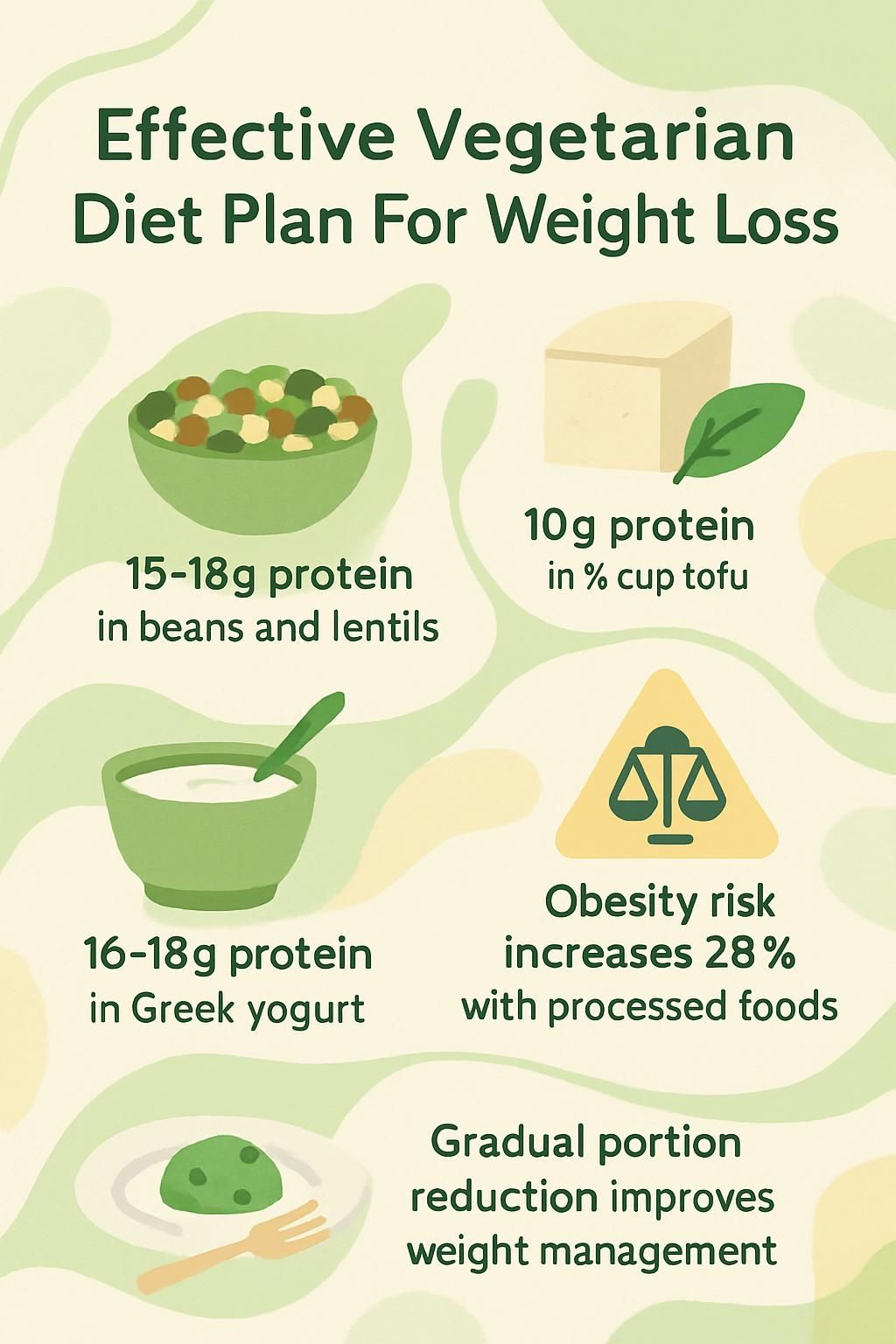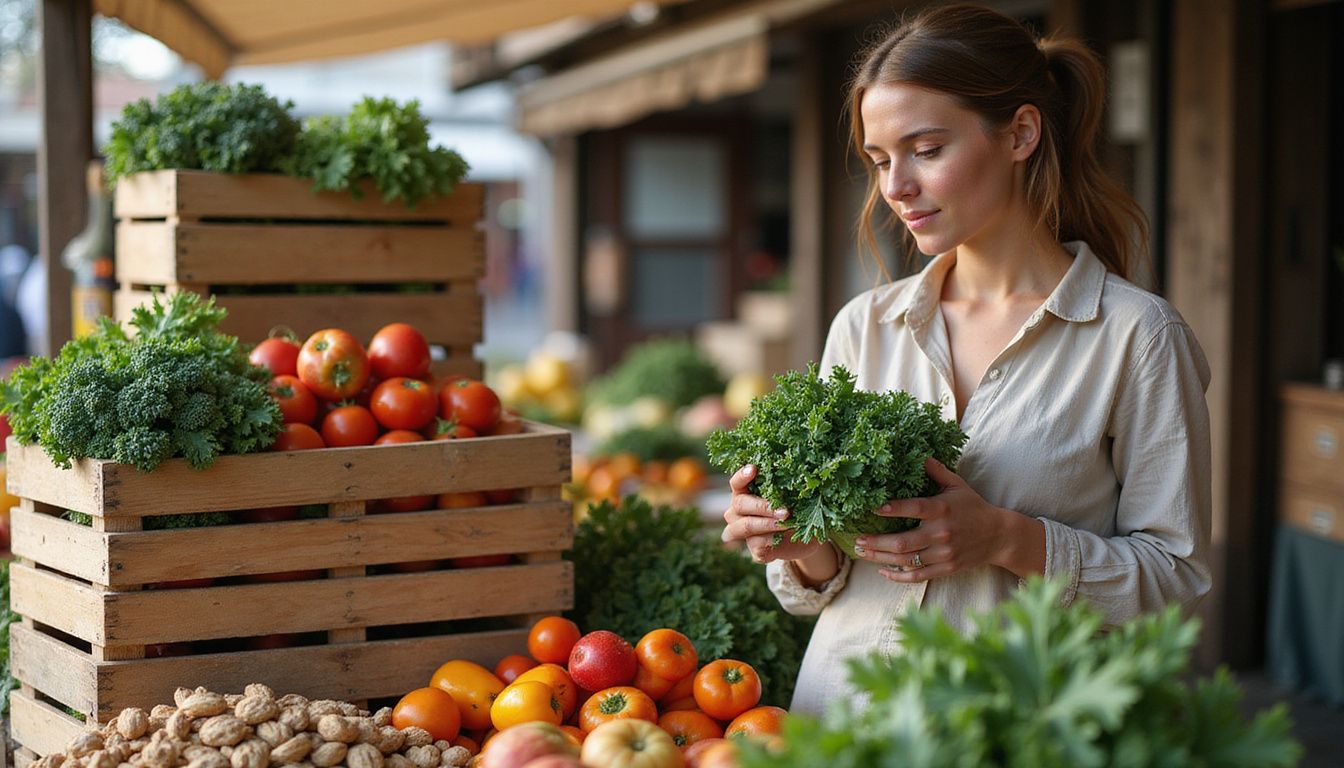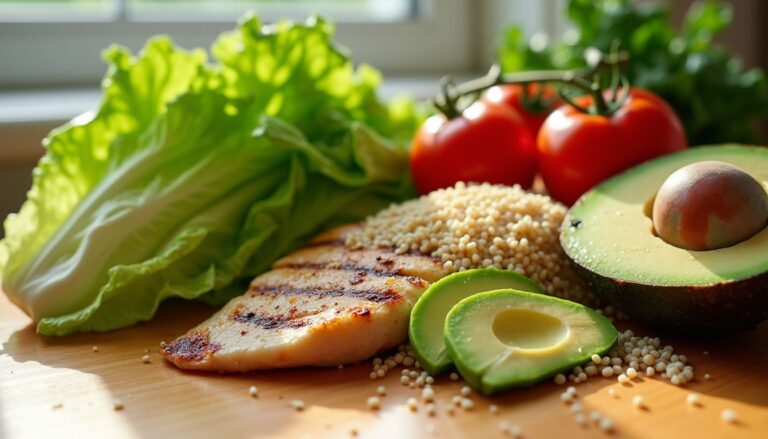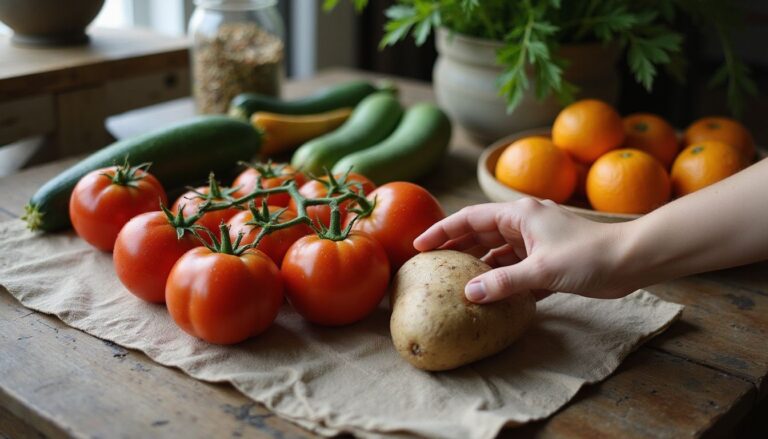Effective Vegetarian Diet Plan For Weight Loss
Our Nutrition Assistant AI Suite will transform your body. You will lose fat, get toned, and build muscle. Gain confidence and optimal health.
You might follow a vegetarian diet for weight loss and still feel stuck. Plant-based eaters often have lower rates of obesity and heart disease, yet results depend on daily choices. This guide gives you simple steps, clear meal ideas, and proven tips to help you lose weight with a healthy vegetarian meal plan.
If you want a plan that works in real life, you are in the right place.
Key Takeaways
- Vegetarian diets link to lower obesity and heart disease risk, but portion control still matters. Foods like nuts and cheese are healthy, yet calories add up fast.
- Whole foods high in fiber, such as leafy greens and whole grains, keep you full and help you manage calories better than refined carbs or packaged snacks.1
- Lean protein from plants supports muscle while you eat fewer calories. Beans and lentils offer about 15 to 18 grams per cup, tofu about 10 grams per half cup, and Greek yogurt 16 to 18 grams per serving.
- Processed vegetarian foods often bring extra sodium and sugar. Regular intake raises daily calories and is linked with a higher risk of obesity.
- Plan balanced meals, reduce portions gradually, and track progress. These habits improve long-term weight management on a structured vegetarian diet plan.
1 Satija et al., Circulation 2016;134:643-654
What Is a Vegetarian Diet?

A vegetarian diet removes meat, fish, and poultry. People choose it for health, faith, or ethical reasons. Many also use this eating pattern to lower the risk of chronic diseases like diabetes and high blood pressure.
Your plate centers on plant foods. That includes fruits and vegetables, whole grains, legumes such as lentils and chickpeas, nuts, and seeds. Meals often have fewer calories and less saturated fat than meat-based meals. If you do not plan well, you might fall short on protein and vitamin B12.
Common types include lacto-ovo vegetarian, which includes eggs and dairy; lacto-vegetarian, which keeps dairy but avoids eggs; and ovo-vegetarian, which allows eggs but skips dairy. Vegans avoid all animal products, including honey.
Vegetarian diets are usually rich in dietary fiber from whole grains and plant foods.
Some people follow a flexitarian plan, which is mostly plant-based with occasional animal foods, or choose a pescatarian style that allows fish. Be selective with packaged snacks that are high in sugar or salt. These can raise your calorie intake even if most of your meals are meat-free.
Types of Vegetarian Diets
You can choose from several vegetarian styles. Knowing the differences helps you match your goals and meet your nutrition needs.
What Is a Lacto-Vegetarian Diet?
A lacto-vegetarian diet excludes meat, fish, poultry, and eggs, but includes dairy foods like milk, yogurt, cheese, and butter. Dairy serves as a key source of protein and calcium for bone health.
This style is common in many cultures, including parts of India. If you eat little dairy, vitamin B12 can drop because plants provide very little. Include protein at each meal, such as low-fat yogurt or cottage cheese, and fill the rest of your plate with whole grains, fruits, and vegetables to support weight management.
What Is an Ovo-Vegetarian Diet?
An ovo-vegetarian pattern skips meat, poultry, seafood, and dairy, yet includes eggs. Eggs bring high-quality protein and important nutrients like choline, which supports brain function.
Since dairy is excluded, watch calcium and vitamin D. Iron and zinc from plants absorb better when paired with vitamin C, so try beans with bell peppers or citrus. If egg intake is low, consider vitamin B12 from fortified foods. Many people like this option if they avoid dairy but want a simple, animal-free protein choice.
What Is a Lacto-Ovo Vegetarian Diet?
A lacto-ovo vegetarian diet avoids meat, fish, and poultry, yet includes eggs and dairy. This style offers many protein choices, including yogurt, eggs, tofu, beans, and lentils. It is the most common vegetarian pattern in the United States.
Health groups note it can support heart health since it limits red meat and includes foods rich in calcium and vitamin B12. When I first switched to this pattern, adding eggs and low-fat dairy kept me full longer than a fully vegan setup. You still need leafy greens and vitamin C-rich produce to support iron intake.
You can meet daily energy and protein needs with dairy or fortified milk substitutes, soy foods, and whole grains.
Build meals with vegetables, beans or eggs, and whole grains. This balance supports steady energy while you work toward your weight goals.
What Is a Vegan Diet?
A vegan diet removes all animal products. That means no meat, poultry, fish, eggs, dairy, or honey. Your protein comes from plants such as lentils, beans, chickpeas, soy foods like tofu or tempeh, nuts, seeds, and mycoprotein.
Vegans often need vitamin B12 from fortified foods or supplements. Calcium and omega-3 fats can also be low, so plan for fortified plant milks, calcium-set tofu, and sources of omega-3 like chia, flax, or algae oil. Studies link vegan diets with lower cholesterol and blood pressure, and a lower body mass index compared with meat-based diets.
To improve iron absorption from plants, pair iron-rich foods, like spinach and beans, with vitamin C foods, such as oranges or tomatoes. With careful planning, you can meet your nutrient needs and support healthy weight loss.
Benefits of a Vegetarian Diet for Weight Loss
A well-planned vegetarian diet can help you lose weight and protect long-term health. Think of it as eating for energy, not just eating fewer calories.
How Does a Vegetarian Diet Lower Calorie Intake?
Non-starchy vegetables, leafy greens, and whole grains have high water and fiber. They fill your plate without adding many calories. You get larger portions for fewer calories compared with many meats and cheeses.
Replacing fatty meats with beans or lentils usually drops your daily calories. When I switched a deli sandwich for a big salad with beans and brown rice, I felt full longer and stopped grazing all afternoon. Portion control still matters, especially with calorie-dense foods like nuts and cheese.
Why Is High Fiber Important for Weight Loss?
Fiber is the part of plants you do not digest. It slows digestion and increases fullness, which helps cut snacking and lowers total calories. People who eat more fiber tend to weigh less than those who eat very little.
Fiber also helps steady blood sugar, so you avoid big spikes and crashes after eating. Build meals with lentils, chickpeas, oats, brown rice, vegetables, and fruit. That mix supports weight loss and better gut health.
How Does a Vegetarian Diet Improve Satiety?
Plant foods often combine fiber, water, and protein. That trio keeps you satisfied longer. Beans, tofu, eggs, yogurt, and vegetables help control hunger between meals.
Fill half your plate with vegetables and add a solid protein. In my week on a simple vegetarian plan, those habits cut late-night snacking and made portions easier to manage.
How Does It Reduce Unhealthy Fat Intake?
Vegetarian diets remove red and processed meats, which are high in saturated fat. This can support heart health and help with weight control. Focus on whole grains, legumes, vegetables, nuts, seeds, olive oil, and avocados for healthier fats.
Limit fried foods and heavy sauces. When I cooked more plant-based meals, my LDL cholesterol dropped within three months. Watch portion sizes for cheese and oils, which add calories quickly.
Common Barriers to Losing Weight on a Vegetarian Diet
Even a plant-forward diet can stall your progress. Spot the common traps so you can avoid them.
Why Can Large Portions of Calorie-Dense Foods Hinder Weight Loss?
Foods like nuts, seeds, avocado, oils, and cheese pack many calories into small portions. Two tablespoons of peanut butter can have about 190 calories. It is easy to overshoot your daily target without noticing.
During my early weight loss effort, I snacked on big handfuls of nuts and gained weight. Smaller bowls and measured portions helped. Pair calorie-dense foods with vegetables or whole grains to build balance.
How Do Refined Carbohydrates Affect Weight Loss?
Refined carbohydrates include white bread, pasta, bagels, pizza crust, and many crackers. They digest fast, which can spike blood sugar and leave you hungry again soon. That cycle often leads to overeating.
Large studies link higher insulin responses from refined carbs with higher body mass index. Swap in brown rice, quinoa, or whole wheat pasta. When I made that switch, I felt satisfied longer and had fewer cravings.
What Are the Risks of Overeating Processed Vegetarian Foods?
Packaged meat substitutes, frozen meals, vegan cheese, and baked goods often contain more sodium, sugar, and additives than you expect. They can be as calorie-dense as non-vegetarian options and less filling than beans or vegetables.
Regular intake of ultra-processed foods links to higher obesity risk and higher LDL cholesterol. Rely more on whole foods. Save the packaged items for busy days, and keep portions in check.
How Can Lack of Protein Impact Weight Loss?
Too little protein can increase hunger and reduce muscle mass during a calorie deficit. Losing muscle lowers metabolism, which can slow progress. Protein also supports your skin, bones, and muscles.
Include beans, lentils, soy foods, dairy, eggs, or nuts at every meal. When I tried a grain-heavy menu with little protein, I felt tired and hungry. Adding tofu, yogurt, or legumes fixed that fast.
Tips for an Effective Vegetarian Diet Plan
Good results come from smart planning and repeatable habits. These steps help you build meals that fit your life.
Why Focus on Whole, Nutrient-Dense Foods?
Whole foods, like vegetables, fruits, whole grains, legumes, nuts, and seeds, deliver fiber and protective plant compounds. Diets centered on these foods link with lower risk of heart disease and some cancers. They also give you more vitamins and minerals per calorie than most processed items.
Choosing beans over a meat alternative burger and adding greens to smoothies helped me reduce cravings at night. Research suggests that getting nutrients from unprocessed foods supports health even when you lower calories.11 Satija et al., Circulation 2016;134:643-654
What Are Lean Plant-Based Protein Sources to Include?
Include protein at every meal to support muscle and curb hunger. Aim for a mix across the week.
- Beans and lentils, about 15 to 18 grams of protein per cooked cup. The fiber boosts fullness.
- Soy foods, such as tofu, tempeh, and edamame. Tofu has about 10 grams per half-cup.
- Nuts and seeds, 5 to 7 grams per ounce. Use small portions due to higher calories.
- Greek yogurt, about 16 to 18 grams per serving, if you include dairy. It also brings calcium.
- Eggs, roughly 6 grams each, for those who choose a lacto-ovo style.
- Low-fat dairy, such as milk or cheese, paired with whole grains for balanced meals.
- Quinoa, about 8 grams per cooked cup, and it contains useful amino acids.
- Green peas, about 8 grams per cooked cup, plus iron and fiber.
These foods support recovery if you exercise and help manage hunger hormones. They also make a vegan or vegetarian plan easier to follow day after day.
How Can You Control Portion Sizes Effectively?
Portions drive your calorie intake. Small, steady changes work best.
- Use smaller plates and bowls to serve less and still feel satisfied.
- Measure calorie-dense foods, like nuts, oils, cheese, and nut butter. Keep nuts to about 1 ounce per snack.
- Fill half your plate with non-starchy vegetables for bulk with fewer calories.
- Limit cooked grains to about 1/2 cup per serving, such as brown rice or quinoa.
- Plan meals and snacks ahead to reduce impulsive eating.
- Reduce portions gradually across a few weeks to build lasting habits.
- Practice mindful eating. Slow down, taste your food, and stop at comfortable fullness.
- Track intake with a food diary or app. Many people underestimate calories by a large margin.
- Build balanced plates: half vegetables, one quarter lean plant protein, one quarter whole grains.
- Switching to salad plates helped me cut more than 200 calories per dinner without extra hunger.
Which Healthy Fats Should You Choose and How Much?
Healthy fats help your body absorb vitamins and regulate hormones. The goal is the right types and sensible portions.
- Pick avocado, olive oil, nuts, seeds, and nut butter as your main fat sources. These provide omega-3 fats and other nutrients that support heart health.
- Aim for 20 to 30 percent of daily calories from fat to keep meals balanced.
- If you include dairy, use cheese in modest amounts for flavor and calcium.
- Measure high-fat foods. Even plant fats add up fast.
- Pair fats with vegetables or whole grains to help manage appetite.
- Limit fried foods and processed snacks that may contain unhealthy trans fats.
- Rotate fat sources during the week. I felt better focus after adding walnuts to salads in place of croutons.
- A tablespoon of seeds on a grain bowl can lift satiety during the long afternoon.
- Use fortified plant milks or calcium-rich nuts to support bone health if your diet is dairy-free.
These steps let you enjoy flavor and fullness while still staying in a calorie range that supports weight loss.
Why Limit Processed and Sugary Foods?
Processed vegetarian foods can be heavy in sodium, additives, and sugar. Studies show higher intake of ultra-processed foods links to more weight gain and insulin resistance. Sugary drinks and snacks cause quick blood sugar spikes that lead to hunger later.
Read labels and watch for added sugars in bars, sauces, and cereals. I once grabbed a plant-based breakfast bar and later noticed several sweeteners listed near the top of the label. Whole foods offer steadier energy and better nutrition.
Vegetarian Foods That Aid Weight Loss
Smart choices do more than cut calories. They keep you full, bring key nutrients, and make meals satisfying.
How Do Leafy Greens and Cruciferous Vegetables Help?
Spinach, kale, romaine, broccoli, cauliflower, and cabbage are low in calories and high in fiber and micronutrients. You can eat generous portions without overshooting your calorie goals.
Half a plate of these vegetables adds volume and supports regular digestion. During a recent week, roasted broccoli at lunch and a spinach salad at dinner kept my energy steady until bedtime.
Why Include Whole Grains Like Quinoa and Brown Rice?
Whole grains supply complex carbohydrates and fiber. They digest slowly, which steadies blood sugar and reduces cravings. Many vegetarian meal plans suggest several ounces of whole grains daily for sustained energy.
Quinoa and brown rice are easy swaps for refined options. I began using brown rice at lunch and noticed better fullness through the afternoon.
How Do Legumes Such as Lentils and Chickpeas Support Weight Loss?
Legumes provide protein and fiber in the same food, a great combo for fullness. A cup of cooked lentils offers about 18 grams of protein and 16 grams of fiber. Chickpeas offer similar benefits and bring iron and folate as well.
Try lentil soup, chickpea salad, or bean curries. I like a warm lentil bowl at lunch because it keeps me satisfied until dinner.
When and How Should You Eat Nuts and Seeds?
Nuts and seeds deliver healthy fats, plant protein, and minerals. They are calorie-dense, so portions matter. Two tablespoons of peanut butter can have about 190 calories.
Enjoy a small handful of nuts, or measure 1 to 2 tablespoons of seeds. Add almonds to oatmeal or chia to yogurt. I often use a spoonful of sunflower seeds on salads for crunch and staying power.
Foods to Avoid on a Vegetarian Diet for Weight Loss
Some vegetarian foods make weight loss harder. These swaps protect your progress and your health.
Why Avoid Highly Processed Meat Substitutes?
Many meat substitutes contain high sodium, added sugars, and refined oils. They can be just as calorie-dense as regular meat and less filling than beans or tofu.
Frequent use can raise your sodium intake and may affect blood pressure. When I replaced veggie burgers with lentils and vegetables, I had more energy and better satiety.
How Do Sugary Snacks and Beverages Affect Weight Loss?
Sodas, sweet teas, fruit drinks, and pastries deliver many calories with few nutrients. The quick sugar rush often leads to an energy crash and more hunger later.
Excess added sugar increases the risk of weight gain and metabolic problems over time. Cutting back makes it easier to manage calories and maintain steady energy.
Why Limit Refined Grains Like White Bread and Pasta?
White bread, pasta, bagels, and crackers lack fiber and digest quickly. They can spike blood sugar, then leave you hungry soon after. That pattern can push you to eat more than you planned.
Choosing whole grains supports steady energy and better fullness. Switching from white bread to whole wheat helped me avoid snacking between meals.
Nutritional Comparison Table: Refined vs Whole Grain (per typical serving)
| Food | Calories | Fiber (g) | Key Nutrients |
|---|---|---|---|
| White Bread, 1 slice | 70 | 0.7 | Lower in vitamins |
| Whole Wheat Bread, 1 slice | 70 | 2 | Iron, B vitamins |
| White Pasta, 1 cup cooked | 200 | <1 | Lower in minerals |
| Brown Rice, 1 cup cooked | 215 | 3 to 4 | Magnesium, selenium |
Whole grains help keep hunger steady, which supports a vegetarian diet plan for healthy weight control.
What Are the Downsides of Calorie-Rich Fried Foods?
Fried snacks, like samosas and pakoras, bring a lot of oil and calories. They may raise the risk of weight gain and heart issues when eaten often. Frying can also lower some nutrients.
I swapped chips for roasted vegetables and felt fuller with fewer calories. Baked, steamed, or grilled options support your goals and still taste great.
Sample Vegetarian Meal Plan for Weight Loss
Here is a simple 4-day sample to jump-start your routine. Mix and match as needed.
What Does Day 1’s Meal Plan Look Like?
Breakfast: Steel-cut oats with chopped apple, a spoon of peanut butter, and cinnamon.
Lunch: Big greens salad with hard-boiled eggs, tomatoes, avocado, and balsamic vinaigrette.
Dinner: Black bean soup with a slice of whole-grain bread, Greek yogurt, and a side salad.
Snack: Small handful of almonds with a few dark chocolate chips.
Each meal includes protein and fiber to keep you satisfied.
What Are the Meals for Day 2?
Breakfast: Scrambled eggs with broccoli and a sprinkle of cheddar. Add berries on the side.
Lunch: Burrito bowl with brown rice, pinto beans, salsa, onions, tomato, and avocado.
Dinner: Zucchini noodles with marinara, white beans, and a sprinkle of sunflower seeds.
Snack: String cheese or an orange, based on your preference.
This mix brings protein, fiber, and healthy fats in each meal.
What Is Included in Day 3’s Meal Plan?
Breakfast: Plain Greek yogurt with berries and seeds, or daliya with a piece of fruit.
Lunch: Lentil soup with a side of guacamole, or vegetable fried rice made with brown rice plus a small bowl of curd.
Dinner: Baked eggplant Parmesan over whole-grain pasta, or tofu stir-fry with bell peppers and broccoli.
Snacks: A whole-grain granola bar, or citrus-style bhel puri with light dressing.
Protein and fiber at every meal help manage hunger as you lose weight.
What Are the Day 4 Meal Options?
Breakfast: Smoothie bowl with almond milk, spinach, hemp seeds, berries, and banana. Top with a few nuts or extra fruit.
Lunch: Egg salad on whole-grain bread with strawberries, plus carrots and hummus.
Dinner: Tofu stir-fry with carrots and broccoli over brown rice. Use low-sodium soy sauce and a touch of honey for flavor.
Snack: Dried mango and pistachios, measured portions.
These meals balance protein, healthy fats, and carbs, roughly 1,200 to 1,500 calories per day depending on portions.
Additional Tips for Sustainable Weight Loss
Small, steady actions build momentum. Keep what works and adjust the rest.
How Much Water Should You Drink for Weight Loss?
Water supports fullness and helps you manage appetite. A simple goal is eight 8-ounce glasses per day, about 2 liters. Drinking about two cups before meals helped people lose more weight in a 12-week study.
If you are active or it is hot outside, you may need more. Ask your clinician or a registered dietitian if you have medical conditions that affect fluid needs.
What Types of Physical Activity Are Best?
Aim for at least 150 minutes of moderate cardio weekly. Brisk walking, cycling, swimming, hiking, or dancing are solid options. They burn calories and support heart health.
Add strength training twice a week with bodyweight moves like squats, push-ups, and lunges. More muscle helps you burn more calories at rest.
How Can You Track Progress and Adjust Your Plan?
Log meals, snacks, and portions in a notebook or app. Look for patterns like frequent refined carbs or large portions of nuts and cheese. Adjust meals so half your plate is vegetables, then add protein and whole grains.
Check hunger before and after meals and tweak portions. For personal guidance, meet with a registered dietitian who can tailor your plan to your health goals.
Why Is Consistency and Patience Important?
Lasting change takes time. Many people see steady progress after several weeks of consistent habits. Safe weight loss is usually 1 to 2 pounds per week.
In my experience, the largest changes showed up after three months of steady meals and routine exercise. Slow progress still counts, and it lasts longer.
Conclusion
A structured vegetarian diet for weight loss focuses on whole foods, lean plant proteins, and fiber-rich vegetables. These choices boost fullness, control calories, and help you avoid heavy dependence on refined carbs and ultra-processed snacks. Plan meals, watch portions, and track your progress for steady results.
This article is informational and does not replace medical advice. If you have a medical condition, take medications, or need special guidance, speak with your healthcare professional or a registered dietitian before changing your diet.
FAQs
1. What are the main components of an effective vegetarian diet plan for weight loss?
A successful vegetarian diet plan for weight loss includes a balance of plant-based proteins, whole grains, fruits, vegetables, and healthy fats. Research from the Academy of Nutrition and Dietetics shows that diets rich in fiber and low in processed foods support steady weight loss.
2. How much protein should I eat on a vegetarian diet to lose weight?
Adults aiming for weight loss need about 0.8 to 1 gram of protein per kilogram of body weight each day according to Harvard Health Publishing. Good sources include lentils, chickpeas, tofu, tempeh, Greek yogurt, cottage cheese, nuts, and seeds.
3. Can a vegetarian meal plan provide enough nutrients while losing weight?
Yes; studies published in The American Journal of Clinical Nutrition confirm that well-planned vegetarian diets meet all nutrient needs during calorie reduction if they include iron-rich beans or spinach plus vitamin B12-fortified foods or supplements.
4. What is one example of how someone has used this type of eating plan successfully?
After switching to a structured plant-based meal schedule with measured portions and regular exercise last year I lost fifteen pounds over four months without feeling deprived or tired; tracking meals helped me stay consistent with my goals.
Summary: An evidence-based approach supports using balanced plant-focused meals high in fiber and protein for safe sustainable fat loss while meeting nutritional requirements through careful food choices and planning.







